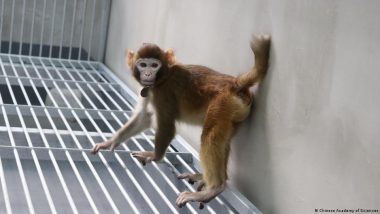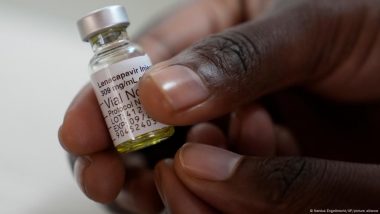Cloning primates is complicated. In most attempts, embryos and newborns die. But researchers in China say they’ve cloned a rhesus monkey that’s doing well.When researchers created Dolly the Sheep by cloning, it was the first time they had had such success with a technology known as somatic cell cloning — or somatic cell nuclear transfer.
That was in 1996, and in the nearly three decades since, researchers have successfully tried and tested the same technology on a further 20 mammalian species.
Also Read | NASA Postpones Artemis III Mission Till at Least 2026.
Cloned mammalian animals often suffer from damage to their muscles and/or other organs, and that dramatically reduces their life expectancy. Cows have so far had the best chances of staying alive.
Primates have had the lowest chance of birth and survival.
In early 2018, however, it was reported that two cloned macaque monkeys, Zhong Zhong and Hua Hua, had been born the previous November at the Institute of Neuroscience of the Chinese Academy of Sciences in Shanghai. The world of research considered it a sensation.
And now the same institute has published a new success story: Researchers there have managed to clone a rhesus monkey. The male is said to be healthy and happy and already two years old. Their research has been published in the science journal Nature Communications.
Is a cloned rhesus monkey a breakthrough for science?
"The study and the technology they present tell a very special and biologically interesting story," said Rüdiger Behr, a stem cell and embryo researcher at the German Primate Center. "But I doubt we're seeing anything fundamentally new, or anything that will find a broad application in the science community."
Behr said the researchers in China used a technique that only few laboratories in the world could replicate.
"They created a combination embryo — one part cloned and another part not-cloned," said Behr. He added it was hard enough to develop a [fully] cloned embryo, implying that this technique was even harder.
How does cloning work and why is it so difficult?
The biggest challenge in cloning — that is, creating an exact genetic copy of a complex lifeform — is the clone's survival. Most cloned animals have poor health and short lives.
As with human animals, all animals and other living organisms are made of somatic cells. A somatic cell is any cell that is not a reproductive cell, such as sperm and egg cells, which are called germ cells.
In somatic cell cloning, researchers plant the cell nucleus of a somatic cell, such as a nerve cell, into an egg cell that's had its own cell nucleus removed.
"When [you do that], the egg cell can reset the cell nucleus of the somatic cell so that the entire construct behaves as though the egg were fertilized," explained Behr. And from that, you get an embryo.
The fertilized egg cell begins to divide, creating exact copies of itself. But the more the cells divide, the more they differentiate themselves from each other and their functions — they become skin, heart, muscle and nerve cells.
The genetic information in each of these cell nuclei is the same, but not every gene gets "read". Think of genes as the words or pictures in a Lego manual — if you skip a page, you end up building something different from what's pictured on the box. That is how different cell types are formed.
But with this technique, the egg cell reprograms the implanted somatic cell nucleus to allow all the genes to be read — the same as when you reset your phone to the default or factory settings, the cells start afresh. That is the theory, anyway.
"It doesn't always work very well," said Behr, alluding to the low efficiency rate in cloning.
Is it especially difficult to clone primates?
When it comes to efficiency rates, the current study is no exception: Of 484 implanted embryos, only one was born alive.
But it's almost impossible to know, said Behr, whether that one successful birth was due to the new technique or pure chance.
In principle, said Behr, it is not fundamentally more difficult to clone primates than mammals.
"There are only very few institutes in the world that can even conduct such experiments with primates, so, in my opinion, the fact that cloning remains difficult has more to do with the fact that we've so little experience with cloning monkeys," he said.
Keeping monkeys for research is more intensive and expensive than keeping mice, said Behr, so we're making slower progress with monkeys (and more with mice).
Why clone monkeys at all?
There is a lot of interest in cloning monkeys because non-human primates, such as monkeys, are biologically similar to human primates — like you and me. And researchers hope to use monkeys more in medical research for treatments for Alzheimer's and Parkinson's diseases.
If researchers could conduct experiments on groups of genetically cloned monkeys and compare the results to the same tests on non-cloned monkeys, they believe positive medical findings would transfer better to humans than if the experiments were conducted only on mice, for example.
"As a PhD candidate, I couldn't imagine that one would want to clone monkeys," said Behr, "that was a red line for me. Monkeys are too similar to humans, too sensitive to pain."
Behr said he sees things differently now, though, and that there are situations in which cloning monkeys may be appropriate, such as for "untreatable diseases that cause great suffering."
One goal is to develop gene therapies for visual impairment, deafness, heart disease and metabolic conditions. But no one knows, conceded Behr, whether cloning monkeys will ever help us find the treatments we desire.
This article was originally published in German.
(The above story first appeared on LatestLY on Jan 16, 2024 10:10 PM IST. For more news and updates on politics, world, sports, entertainment and lifestyle, log on to our website latestly.com).













 Quickly
Quickly





















